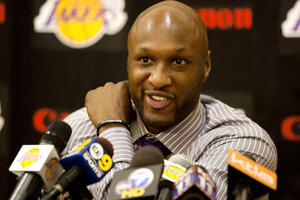Lamar Odom's case may highlight a bigger issue for pro athletes
Some experts say professional sports leagues such as the NBA and NFL don’t adequately prepare athletes for life after the spotlight.

In this July 31, 2009, file photo, Los Angeles Lakers' Lamar Odom speaks to the media during a news conference after the Lakers signed Odom to a multi-year NBA basketball contract, in El Segundo, Calif. Odom spent most of his 14-year NBA career in Los Angeles with the Lakers and Clippers, becoming a fan favorite before he sought even more fame with the Kardashians. Odom, who was embraced by teammates and television fans alike for his Everyman approach to fame, was found face-down and alone Tuesday, Oct. 13, 2015, after spending four days at the Love Ranch, a legal Nevada brothel.
Jeff Lewis/AP
As family and friends surround former basketball star Lamar Odom with love and well wishes, his health scare Tuesday at a Las Vegas brothel highlights some troubling issues professional athletes sometimes face upon retirement.
After being chosen fourth overall in the 1999 NBA draft, Mr. Odom had a successful 14-year career in Los Angeles with both the Clippers and Lakers. Although he earned fame in his own right, his 2009 marriage to Khloe Kardasian, and subsequent appearances on various reality TV shows, made him even more notable.
Fans are left wondering exactly how the former pro athlete ended up in a Las Vegas hospital. A causal relationship can't be confirmed, but like a number of ex-pro sports stars, Odom may not have planned well for retirement.
“You’re talking about an identity crisis,” National Football League (NFL) vice president of player engagement and former Pro Bowl cornerback Troy Vincent tells ESPN. “Every athlete has to face the same question when they’re done: ‘Who am I?’”
“I didn’t know how to be a regular person,” Olympic gymnast Shannon Miller, who retired from her sport in 2001, explained to Robert Laura at Forbes magazine. “What do I get up and do every day? Gymnastics was such a love and passion that to have that part of your heart taken away is hard…. I had to set new goals without really knowing where they may take me.”
After living with a structured schedule of practices and interviews, some former athletes fill the their free time with new careers. Charles Barkley and Tiki Barber work as sports commentators while Michael Jordan and Magic Johnson both started business ventures. But even when athletes find productive ways to spend their time, some still feel dissatisfied with retirement.
“These endeavors usually do not provide the same adrenaline rush experienced while playing sports,” Dr. Kevin Burke, a sport psychology professor in Charlotte, North Carolina, wrote Thursday for Sporting News. “In attempting to find action exciting and exhilarating as playing sports, sometimes athletes will make risky choices to re-live those feelings.”
The majority of athletes suffer from both emotional and financial struggles. According to a 2009 Sports Illustrated article, 60 percent of former NBA players are broke within five years of retirement and 78 percent of former NFL players experience either bankruptcy or financial stress within only two years of retirement.
Some experts say professional sports leagues such as the NBA and NFL don’t adequately prepare athletes for life after the spotlight.
“For athletes whose careers are experienced within a condensed time-frame and in high-profile style, the challenge presented may be the truest test of sports’ reputation for preparing participants for real world experiences,” says Dr. Burke.
Instead of providing counseling and advice, most players are shut out from their teams and barred from places that used to be their home, such as practices or locker rooms. And NFL players are unable to explore potential post-career professions because they are prohibited from outside employment during the offseason.
Jim Steeg, a notable sports executive, says colleges need to start taking responsibility for their student athletes' education.
“Schools need to help, encourage and support players to get a substantive degree within three to five years of his departure,” Mr. Steeg writes for USA Today. “It seems to me that universities are much more concerned about getting their pros to donate to the athletic program than getting them to fulfill their commitment to graduate.”

